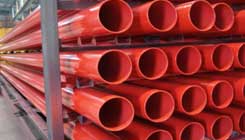The CPVC pipes and fittings are extremely useful and are most suitable for any kind of sprinkler system because of their corrosion resistance, longer and reliable performance without the threat of copper leaching and subsequent water contamination. These pipes are cost-effective solutions over traditional sprinkler pipings. These pipes are technically superior and offer versatile performance for different usages. Designed as per the modern industrial standards, these are immune to any kind of harmful chemical reactions of acids and other organic chemicals.
Our supplied pipes and pipe fittings are lightweight, making them easy to use while reducing transportation and installation costs. The jointing of these pipes is fairly simple because it requires no special tool for cutting.
Among all, the CPVC and Galvanized Steel - pipes & fittings are the most widely used plumbing systems in all commercial and industrial buildings, including Office buildings, Education, Healthcare, Hospitality, etc. They feature superior corrosion resistance, longer and reliable performance without the threat of copper leaching and subsequent water contamination. Also, they are available in various diameters and lengths based on the customer's requirement.
Dutco Tennant LLC’s supplied Sprinkler Pipes & Fittings are manufactured under strict quality control with the latest technology conforming regulatory standards. Dutco Tennant’s Sprinkler Pipes & Fittings are best preferred for efficient use of water, fertilizers, and electricity in irrigation of a variety of crops like cotton, soybean, wheat, gram, groundnut, pulses, etc. Also used for checking of dust pollution in cement industries and mining pits. Sprinkler pipes are also used for playground, golf course, huge gardens maintenance. Our Sprinkler Pipes & Fittings have been preferred over available resources due to varied salient features.
We are reckoned to be a preeminent pipe and pipe fittings supplier in the market. Our assortment of pipe fittings is manufactured using high-grade materials and made in compliance with international standards. These Industrial Pipe Fittings are made available to the clients in various sizes, dimensions and shapes to suit the clients’ requirements. Owing to their special features such as robust construction, superior performance, corrosion resistance, and easy installation, they are highly demanded in the market. Dutco Tennant LLC has been able to earn an honorable position in the market of the Middle East and GCC region as a trusted supplier of various kinds of industrial and engineering solutions. We are known among the customers for our uncompromised service and time punctuality and also as a company which always provides the best solution for every demand.

Galvanised Steel

